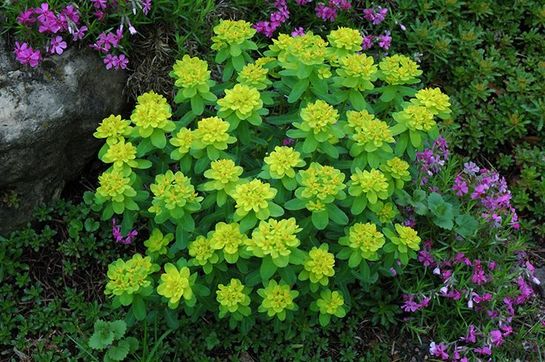spurge (Euphorbia epithymoides polychroma)
|
Genus: Euphorbia (yoo-FOR-bee-uh) epithymoides (polychroma) (cushion spurge)
Common name: Spurge, cushion spurge Benefits: Attracts: butterflies. Deer/rabbit resistant. Group: Dicot Genus: Euphorbia Family:Euphorbiaceae (yoo-for-bee-AY-see-ee) Species: Euphorbia epithymoides (polychroma) Type: Perennial Hardiness: Zones 4 - 8 Bloom Time: Mid spring - late summer Exposure: Full sun, dappled shade Height: 12" - 18" Spread: 8'' - 12" Description: Euphorbia epithymoides (cushion spurge), is a mounding, clump-forming perennial which typically grows in a dome (or cushion) shape to 12-18" tall and as wide on erect, sturdy stems bearing oblong, downy, medium green leaves (to 2" long). Cymes of inconspicuous greenish flowers (lacking both sepals and petals) bloom at the stem ends in spring. Although the flower cymes are not showy, they are subtended by long-lasting, bright sulphur-yellow bracts which are exceptionally showy. Leaves turn red in fall.It is a compact, clump-forming, herbaceous perennial growing to 45 cm (18 in), bearing terminal cymes of acid yellow flower-heads (cyathia) in spring and summer. Like all members of the family Euphorbiaceae, spurges have unisexual flowers. Cultivation: Best grown in dry, well-drained soils in full sun. Appreciates some light afternoon shade in hot summer climates. However, Quite tolerant of poor soils, including rocky, sandy ones. Fertilizing: Soil and pH: Normal or sandy Water: Drought tolerant Pests/Diseases: Generally problem free Reflowering: Clumps tend to open up and lose their attractive cushion shape in too much shade. Trimming back hard (to 4 inches) in early summer will keep this bushy and compact. Propogation/Transplanting: By seed. Seed can last up to 7 years in the ground. Freely self-seeds. Promptly remove spent flowers (shearing plants to shape is one option) to prevent any unwanted self-seeding. Plants can be divided in fall or very early spring. Notes/Garden Tips: CAUTION: Stems exude a toxic, milky sap when cut. Skin and eye irritant/toxic if eaten. When large succulent spurges in a greenhouse are cut, vapors can cause irritation to the eyes and throat several feet away. Precautions, including sufficient ventilation, are required. Euphorbia epithymoides, synonymous with Euphorbia polychroma, is a species of flowering plant in the family Euphorbiaceae, native to Libya, Turkey and East, Middle, and Southeast Europe. The common name "spurge" derives from the Middle English/Old French espurge ("to purge"), due to the use of the plant's sap as a purgative. The botanical name Euphorbia derives from Euphorbos, the Greek physician of king Juba II of Numidia (52–50 BC – 23 AD), who married the daughter of Anthony and Cleopatra. Juba was a prolific writer on various subjects, including natural history. Euphorbos wrote that one of the cactus-like euphorbias (now called Euphorbia obtusifolia ssp. regis-jubae) was used as a powerful laxative. In 12 BC, Juba named this plant after his physician Euphorbos, as Augustus Caesar had dedicated a statue to the brother of Euphorbos, Antonius Musa, who was the personal physician of Augustus. In 1753, botanist and taxonomist Carl Linnaeus assigned the name Euphorbia to the entire genus in the physician's honor. Thank you, Wikipedia! |

